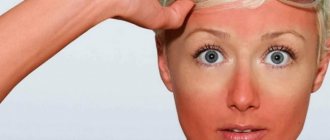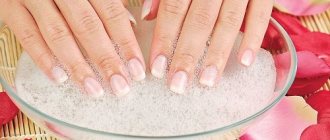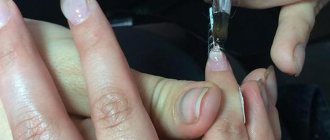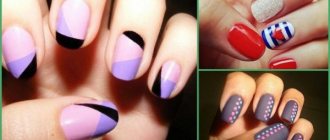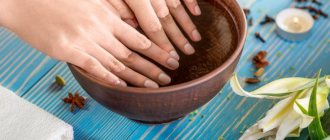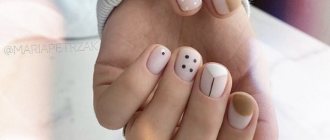Gel polish is a common means for decorating girls’ nails, which remains in the same condition for up to a month. Because of this, most of them prefer to constantly renew their manicure, not allowing the nail plate to rest and recover.
After wearing a decorative coating for a long time, the condition of a natural manicure can gradually deteriorate - it becomes thinner, detachments, yellowness, and dark spots appear, which indicate that it is necessary to undergo nail restoration after gel polish.
Only after it has been carried out will you be able to reapply the pigment, safely for the nail bed.
Nail fungus and gel polish
Fungal infections of the nail plate are quite common. This problem is widespread and requires timely treatment and prevention. The first manifestations of a fungal infection are yellow spots on the nail plate. It is precisely these yellow, unsightly nails that representatives of the fair sex strive to immediately hide under varnish or gel polish. However, this only makes the problem worse.
A fungal infection in the human body can circulate for a long time without manifesting itself. However, with a weakened immune system, the first symptoms of the disease appear. Covering diseased nails with gel polish significantly limits air access to the nail plate. The microcavities between the nail and the gel coating are filled with moisture, which activates the intensive reproduction of pathogenic microorganisms.
It is not recommended to cover nails infected with fungus with gel polish until they are completely cured.
No less relevant is the issue of disinfection of manicure instruments. Often, in order to save money, newly minted masters neglect the rules of sterility, as a result of which clients may become infected not only with fungus, but also with more serious infections (hepatitis, HIV, syphilis).
Treatment of fungal infection
The course of antifungal treatment, according to the recommendations of experts, is at least 3 months. You will also have to forget about your usual manicure for the duration of treatment. However, you can use special antifungal varnishes that will help fight infection and strengthen the affected nail plate.
Antifungal varnishes
- Demicten is an affordable drug from a domestic manufacturer, based on formicaldehyde. This product effectively blocks the spread of fungal infection and promotes the speedy recovery of the diseased nail.
- Oflomil is used both for the treatment and prevention of this disease. The drug often causes a burning sensation in the area of application and has certain contraindications for use.
- Nail Defender has a strengthening and restorative effect on the nail plate. The product is an excellent preventative drug that accelerates the growth of nail plates.
- Aventis is quite effective even with advanced fungus, and is safe for children and pregnant women.

The use of antifungal varnishes gives good results, but it is important to understand that this infection requires an integrated approach to solving the problem. To maximize the effectiveness of therapy, antifungal drugs are additionally prescribed in tablet form. In some cases, treatment is supplemented with antihistamines and vitamins.
Precautionary measures
The main condition for a safe manicure is a trusted master and his compliance with the rules for disinfecting working tools. Salons often offer their clients the use of disposable attachments, which significantly reduces the risk of spreading a fungal infection. Instruments and premises in such institutions are subject to regular and complete disinfection. At home, it is much more difficult for a specialist to ensure maximum sterility of the procedure. It is important to understand that treating an instrument with an ultraviolet lamp or boiling does not provide a 100% guarantee that the fungal infection has been eliminated.
If signs of a fungal infection are detected on the client’s nails, the responsible master must refuse the service and refer him for a consultation with a dermatologist. It is this algorithm of the master’s actions that is considered correct in this situation.

How to remove shellac with acetone and foil: instructions
If you decide to remove shellac yourself, you must understand that doing it without a professional will be much more difficult. The gel adheres to the nail so strongly that if it is removed in an inaccurate manner, part of the plate will also be removed. Of course, you won’t remove them completely, but you will do a lot of damage.
For the procedure, you will need to take a liquid with acetone, as well as cotton pads for impregnation. Moreover, you will have to directly remove the shellac with an orange stick. As an option, you can take a plastic one, but the first one is still better. Don't forget to take foil. It will be needed to create a thermal effect. In principle, any will do. Well, to complete the work you will need a sanding file.
The process itself includes several stages:
- Lubricate your hands with any high-fat cream. Acetone is aggressive to the skin and can harm it. So be sure to apply cream.
- Next, take the discs and wet them in acetone. Place it on each finger one by one and wrap it in foil on top.
- It is enough to hold the caps for about 10 minutes. Then they can be removed and you can start working on the coating itself. The procedure is carried out separately for each nail.
Remove the varnish sequentially. First do one nail, then the second. If you remove all the caps at once, the coating will harden again.
- When everything is removed, wash your hands and use a nail file to set the desired shape. If irregularities suddenly appear on the plates, treat them with a polishing file.
For best results, it is recommended to take an oil bath to soothe your nails.
How to behave when identifying a fungus
If a fungal infection has already manifested itself in some way, it is important to take precautions to avoid worsening the condition of the nails.
- Before performing a manicure or pedicure (on your own), hands and feet should be thoroughly washed with soap and the nails should be cleaned from the inside, after which you can trim the cuticles and file the nails.
- It is unacceptable to have nail extensions if you have already had to treat a fungal infection. In this case, the body is highly susceptible to re-exacerbation.
- It is not recommended to use too thick and old varnishes for manicure.
- Traumatic damage to the skin around the affected nail plates should be avoided.
- It is recommended to temporarily stop using decorative varnishes and give preference to medicinal ones. For decoration purposes, it is better to use rhinestones and sparkles in manicure.
- The manicure tool for an infected person must be individual.
How to easily remove shellac at home without damaging your nails: methods
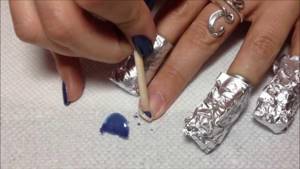
Today, there are many ways to remove shellac yourself. And here are some of them:
- Using a manicure machine . It really is possible. Thanks to the device, removal is painless and much faster. At the same time, you still have to learn how to use it.
- Acetone and foil . This is one of the most popular methods. It allows you to first soften the coating with acetone and then remove it with a spatula.
- File . And it may be useful in this matter. You just have to work with it carefully so as not to damage your own nails.
Let's look at each method in more detail.
Possible negative consequences after using gel coatings
Nail gels, despite all their advantages, sometimes have unpleasant effects. Let's look at the main problems that arise after applying gel polish:
- Fungus - occurs in the form of inflammation around the nail, which is accompanied by severe itching and yellowing of the nail plate.
- Individual intolerance to materials - manifests itself after a short interval of time after applying the coating to the nails.
- Thinning of the nail plate - occurs when the technician fails to follow the technology for applying and removing the coating.
Methods for restoring nail plates after using shellac and gel polish
Restoring nails after a bad experience with gel polish is not an easy task, but it is quite doable. A good restorative effect can be achieved both at home and in salons.
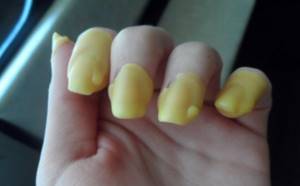
Salon restorative procedures
- Wax sealing of the nail plate. The procedure involves coating the nail plates with a special product based on wax and honey. This composition forms a transparent film on the surface of the damaged nail plate, which significantly strengthens the nail and protects it from mechanical damage and infection.
- Paraffin therapy. The use of paraffin hand baths helps enrich the skin and nails with beneficial microelements. Paraffin is gently distributed over the surface of the skin and nail, filling the smallest areas of damage. After the procedure, your hands look healthier and younger.
- Covering nail plates with biogel. This composition is highly flexible after hardening and allows you to protect weak nails (when peeling) from mechanical damage.
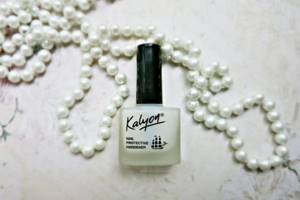
Varnish coating Ship from Kalyon
Treatments in the salon
Treatments at the salon promise a quick cure for nails after shellac. The most popular among them:
- Paraffin therapy. The procedure is largely intended to improve the condition of the skin of the hands, but at the same time it also does an excellent job of treating plates. Warm paraffin saturates with beneficial microelements, but to achieve results you will have to undergo several procedures.
- Sealing. After removing the gel polish, apply a product containing beeswax and honey to the nails. The components provide nutrition and protection. After applying the composition, the plates are carefully polished. As a result, a thin and almost invisible film remains on them. Finally, attention is given to the cuticle and a medicated oil is applied to it.
- Therapeutic nail polish after gel polish. There are many types of special biogel in salons. It is applied in the same way as regular varnish. The resulting layer protects from negative influences, prevents delamination, and nourishes.
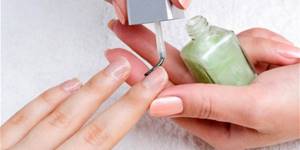
Therapeutic nail polish after gel polish
After strengthening procedures, you need to let the plates recover and avoid using shellac manicure for a while.
Special products for restoring thinning nails
- Ship varnish coating from Kalyon promotes rapid growth of the nail plate and strengthens its structure. The recommended course of treatment is at least 2 weeks. Pearlescent or transparent coating can be used either independently or as a base for decorative varnish.
- Trind Keratin Nail Restorer is a keratin-based product that easily penetrates deep into the nail plate, strengthening and moisturizing it. The coating should be applied twice during the day.
- Base and varnish coating IBX quickly and effectively strengthens thinning nails and restores their healthy appearance. The coating is cured using a UV lamp. It is recommended to use this complex to prevent delamination of the nail plates 1-2 times a month; in advanced cases, it is permissible to use the compositions once a week.
- Moisturizing and softening cuticle oils provide complete nutrition to the cuticle and nail. Comfortable application is possible even with painted nails. It is recommended to lubricate the cuticle 2-3 times during the day.
- Strengthening agent in liquid form - rubbed into the nail plate without applying varnish. It is recommended to repeat the procedure 2-3 times during the day. It takes 3-4 minutes for the product to be absorbed into the nail.
- Restorative varnishes are available on the market in a wide range of colors. This product quickly and reliably protects nails, giving them strength and protecting them from mechanical damaging factors. The main condition for a quality product is the presence of minerals, vitamin complex and calcium.
- The wax coating, intended for home use, is easy to use and has a good restorative effect.
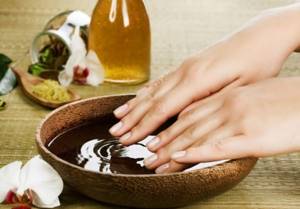
How long should you keep the foil on to remove the shellac?
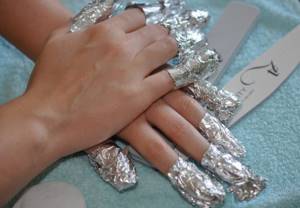
To remove shellac yourself when using foil, you will have to hold it for about ten minutes. But this is only provided that you use a special liquid. If you took a simple nail polish remover, then it is better to increase the time by at least half. Then the varnish will come off the plate better.
Economical options for restoring nail plates at home
- Hand baths with olive oil, sea salt or chamomile. The fingertips should be kept in this composition for 15 minutes, then wiped with a dry towel and lubricated with nourishing cream. It is recommended to repeat the procedure 2-3 times during the week.
- Hand masks. An excellent restorative effect is achieved by using a mask with vitamin E. To do this, you need to pierce the vitamin capsule with a needle and rub the contents over the nail plate and cuticle 30 minutes before bedtime. Lemon is considered a good alternative. It is enough to apply a small amount of lemon juice to your nails and leave it until completely absorbed. Lemon essential oils and vitamin C perfectly strengthen the nail plate. No less popular are masks for hands and nails based on sour berries (currants, rowan, cranberries).
- The iodine mesh stimulates regenerative processes in the nail plate, strengthening its structure and accelerating growth.
Delicious mask
Manicurists love to offer their clients a juicy berry-based mask. The acid, trace elements and vitamins that make up the gifts of summer help to quickly cope with softness and crumbling.
The red currant pulp is crushed and a disposable plastic glove is placed on each finger. These “SPA gloves” need to be put on your hands, making sure that your nails are covered with pulp. After 10 minutes, you can remove the handles, rinse with cool water and lubricate with cream. Thinning nails will literally drink fresh berry juice and be grateful that their thirst is satisfied!

